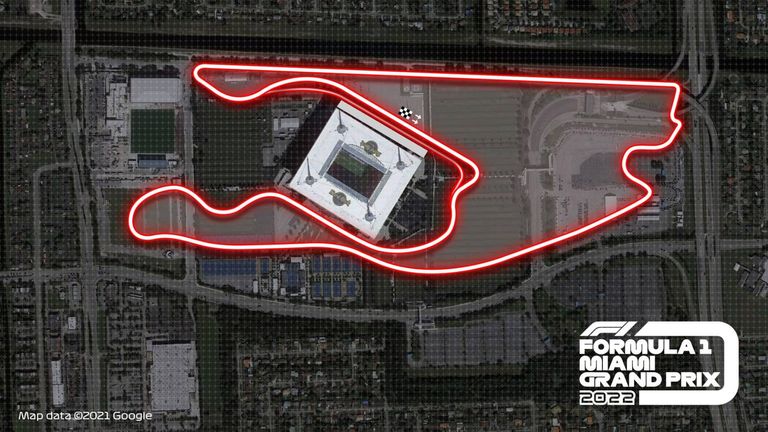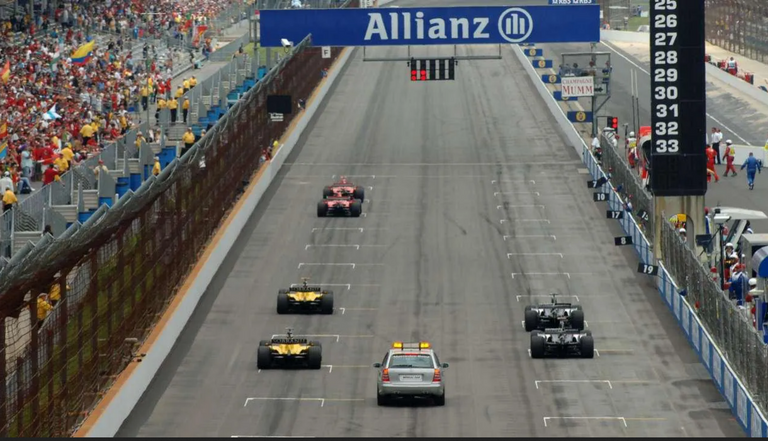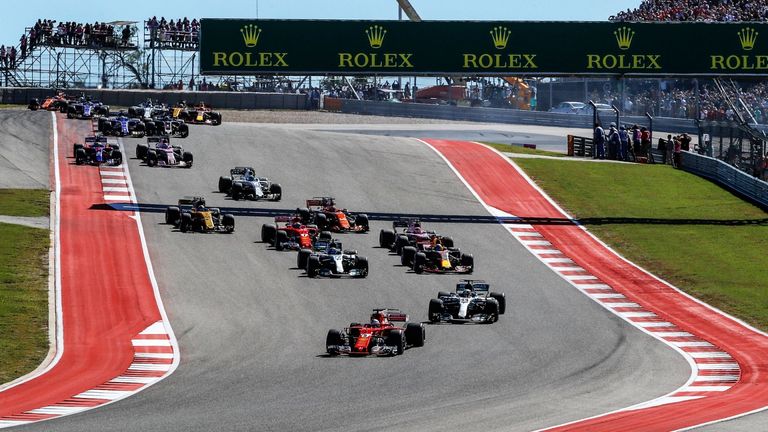
En el primer fin de semana del mes de mayo se disputará en el circuito de Miami EE.UU. el quinto Gran Premio de la temporada 2022 de Fórmula 1.
Que mejor oportunidad entonces que rememorar todas las carreras en la máxima categoría del automovilismo deportivo que se han disputado, a través del tiempo, en el país del norte, donde históricamente fue Indianápolis con sus 500 Millas llevadas a cabo en el Indianapolis Motor Speedway quien concentró por décadas el interés popular en los deportes motores.
Nueve años más tarde de su inauguración oficial (la Fórmula 1 y sus reglamentos tienen como fecha de fundación el año 1948, pero en realidad su debut en las pistas fue en 1950) los EE. UU. se hizo presente por primera vez en el calendario oficial de la F1 en el circuito de Sebring (Sebring International Raceway) en el mes de diciembre cerrando de esa manera la temporada 1959. La carrera fue ganada por el neozelandés Bruce McLaren (falleció en un accidente cuando contaba solo 32 años de edad) que luego le daría su nombre al equipo que tantos títulos y grandes premios supo ganar y que está volviendo a los primeros planos de la F1 en estas últimas temporadas. Su compañero de equipo era ni más ni menos que Jack Brabham, que también supo crear su equipo, hoy desaparecido.
Dada la escasa afluencia de público los organizadores decidieron de nuevo hacer un cambio radical en el escenario y se trasladaron a New York, nace así el Gran Premio de la Fórmula 1 de Watkins Glen donde ya existía un sector del público amante de los deportes que asistía a las carreras automovilísticas en otras categorías. El circuito Watkins Glen International ubicado en el condado homónimo, en el estado de Nueva York se transformó durante 20 años no solo en un récord sino en el emblema de la Fórmula 1 en los EE. UU. con una numerosa afluencia de público y un número cada vez mayor de patrocinadores para el evento.
Con el fin de incentivar la categoría (que hasta ese momento despertaba poco interés) EE. UU. fue incorporada nuevamente al calendario de la F1 aunque esta vez los organizadores prefirieon tentar fortuna en la costa oeste en Riverside (Riverside Internation Raceway) carrera ganada por Stirling Moss que ostenta un curioso récord: es el piloto que más carreras ha ganado (16) sin haber podido ganar nunca un título, razón por la cual se lo conoció como el "rey sin corona": de 1955 a 1960 estuvo siempre en el podio final, subcampeón mundial en cuatro ocasiones consecutivas de 1955 a 1958 y tercero en las dos temporadas restantes: 1959 y 1960. Sólo Indianápolis -más tarde- y Austin -en la actualidad- han logrado darle una cierta regularidad a la F1 en suelo estadounidense.
El circuito fue varias veces ampliado y mejorado, pero a pesar de todo no fue capaz de garantizar la seguridad de los pilotos en una categoría que cada año se estaba transformando en más veloz, pero con autos también más rígidos que no lograban controlar el efecto suelo y llegaron a causar accidentes mortales como los Helmut Koinigg en 1973 y François Cevert en 1974. La FIA encontró en 1981 la excusa legal para eliminar al circuito del calendario de la F1: los organizadores no habían pagado a los equipos participantes los 800.000 USD que les correspondían. El australiano Alan Jones con Williams fue el último ganador.
Las iniciativas por encontrar otro lugar cerca de Nueva York -donde la afluencia de público y fans estaba garantizada- no llevó a ningún resultado y los EE. UU. se quedó sin grandes premios en la Fórmula 1 por dos años. La decisión final cayó sobre Dallas (Texas) pero no tuvo demasiado éxito.
Luego de intensas negociaciones, se eligió a la ciudad símbolo de la industria automotriz, Detroit, para albergar el gran premio de F1 durante cuatro años desde 1985 hasta 1988.
Phoenix inaugura la era de los circuitos callejeros de la F1 en los EE. UU. en 1989, repitiendo en 1990 y 1991. El agobiante calor de Arizona tampoco favoreció una afluencia masiva de espectadores y fue eliminado del calendario. Alain Prost y Ayrton Senna en dos oportunidades se llevaron los triunfos.

On the first weekend of May, the fifth Grand Prix of the 2022 Formula 1 season will be held at the Miami circuit in the United States.
What better opportunity then than to recall all the races in the highest category of motorsports that have been held over time in the northern country, where historically it was Indianapolis with its 500 Miles held at the Indianapolis Motor Speedway that concentrated popular interest in motorsports for decades.
Nine years after its official inauguration (Formula 1 and its regulations were founded in 1948, but in reality its debut on the track was in 1950), the USA was present for the first time in the official F1 calendar at the Sebring International Raceway in December, thus closing the 1959 season. The race was won by the New Zealander Bruce McLaren (he died in an accident when he was only 32 years old) who would later give his name to the team that won so many titles and great prizes and that is returning to the top of F1 in these last seasons. His teammate was none other than Jack Brabham, who was also able to create his team, now defunct.
Given the low attendance, the organizers decided again to make a radical change in the scenario and moved to New York, thus the Watkins Glen Formula 1 Grand Prix was born, where there was already a sector of the sports-loving public who attended car races in other categories. The Watkins Glen International circuit, located in the county of the same name in the state of New York, became not only a record but also the emblem of Formula 1 in the USA for 20 years, with a large number of spectators and an increasing number of sponsors for the event.
In order to boost the category (which until then had attracted little interest), the USA was added back to the Formula 1 calendar. was incorporated back into the F1 calendar, although this time the organizers preferred to try their luck on the west coast at Riverside (Riverside Internation Raceway), a race won by Stirling Moss, who holds a curious record: he is the driver who has won the most races (16) without ever winning a title, which is why he was known as the "king without a crown": from 1955 to 1960 he was always on the final podium, runner-up four consecutive times from 1955 to 1958 and third in the remaining two seasons: 1959 and 1960. Only Indianapolis - later - and Austin - nowadays - have managed to give F1 a certain regularity on American soil.
The circuit was enlarged and improved several times, but in spite of everything it was not able to guarantee the safety of the drivers in a category that was becoming faster every year, but also with stiffer cars that could not control the ground effect and even caused fatal accidents such as those of Helmut Koinigg in 1973 and François Cevert in 1974. In 1981 the FIA found the legal excuse to remove the circuit from the F1 calendar: the organizers had not paid the participating teams the 800,000 USD they were entitled to. The Australian Alan Jones with Williams was the last winner.
Efforts to find another venue near New York - where crowds and fans were guaranteed - led to no result and the USA was left without a Formula 1 Grand Prix for two years. The final decision fell on Dallas (Texas) but was not very successful.
After intense negotiations, the symbol city of the automotive industry, Detroit, was chosen to host the F1 Grand Prix for four years from 1985 to 1988.
Phoenix inaugurated the era of F1 street circuits in the U.S. in 1989, repeating in 1990 and 1991. Arizona's oppressive heat was also not conducive to a massive turnout of spectators and it was removed from the calendar. Alain Prost and Ayrton Senna twice took the wins.
Casi una década de ausencia. / Almost a decade of absence.

Fue recién en los albores del tercer milenio que la Fórmula 1 vuelve a los EE. UU., por ese motivo muchos aficcionados jóvenes no recuerden la cantidad de carreras disputadas con anterioridad.
Y que mejor que el circuito de Indianápolis, con toda su trayectoria automovilística, para inaugurar esta segunda etapa en suelo norteamericano.
El Indianapolis Motor Speedway se transformó en el circuito con mayor presencia de carreras en la Fórmula 1 detrás del histórico Watkins Glen International corriéndose en forma ininterrumpida desde el 2000 hasta el 2007 incluso. Tal vez el final un poco anticipado fue preanunciado en el año 2005. Recuerdo con cuanta pena vi la Ferrari de Michael Schumacher seguido por su compañero Rubens Barricchello llegar a la meta casi a paso de hombre entre la silbatina general de todo el estadio, en una parodia de carrera de F1.
En las pruebas de clasificación todos los equipos (siete en total) que montaban pneumáticos Michelin se retiraron de la competencia luego de haber corroborado una falla en las pruebas de clasificación que podía poner en serio peligro la incolumnidad de los pilotos. Lo curioso es que todos los monoplazas con gomas de la casa francesa hicieron el giro de reconocimiento previo a la largada de la carrera. Terminado el mismo en vez de alinearse embocaron la calle que daba a los boxes y se retiraron.
De esta manera se alinearon en la parrilla de largada solo seis monoplazas: los dos Ferrari, los dos Minardi y los dos Jordan, con una enorme disparidad de rendimiento, razón por la cuál Ferrari hizo una carrera controlada tratando de no distanciarse demasiado de sus rivales, para darle a la competencia un mínimo de sentido.
El Gran Premio de Indianápolis sólo pudo sobrevivir dos años a la feroz andanada de críticas que provocó el desarrollo de este gran premio. Si esta carrera continuó disputándose todavía un par de años más fue porque Michelin no solo devolvió el dinero de las entradas a los participantes sino porque además regaló 20.000 entradas para la carrera del año siguiente.

It was only at the dawn of the third millennium that Formula 1 returned to the U.S., which is why many young fans do not remember the number of races held previously.
And what better than the Indianapolis Motor Speedway, with all its motorsport history, to inaugurate this second stage on North American soil.
The Indianapolis Motor Speedway became the circuit with the largest number of races in Formula 1 after the historic Watkins Glen International, running uninterruptedly from 2000 to 2007. Perhaps the end, a little early, was announced in 2005. I remember how sadly I saw Michael Schumacher's Ferrari followed by his teammate Rubens Barricchello reach the finish line almost at a man's pace amidst the general whistling of the whole stadium, in a parody of an F1 race.
In the qualifying tests all the teams (seven in total) that were using Michelin tires withdrew from the competition after having corroborated a fault in the qualifying tests that could seriously jeopardize the drivers' safety. The curious thing is that all the single-seaters with tires from the French company made the reconnaissance lap prior to the start of the race. When they finished, instead of lining up, they entered the street leading to the pits and retired.
In this way, only six cars lined up on the starting grid: the two Ferraris, the two Minardis and the two Jordans, with an enormous disparity in performance, which is why Ferrari had a controlled race, trying not to distance itself too much from its rivals, in order to give the competition a minimum of sense.
The Indianapolis Grand Prix could only survive for two years the fierce barrage of criticism that the development of this grand prix provoked. If this race continued to be held for a couple more years, it was because Michelin not only refunded the entry fee to the participants, but also gave away 20,000 tickets for the following year's race.
Segundo intervalo sin carreras. / Second interval without races.

El escándalo desatado después del Gran Premio de Indianápolis en 2005 y la eliminación del circuito del calendario de la F1 en el 2007 provocó una fuerte desilusión en los fans estadounidenses de la máxima categoría del automovislismo deportivo que habían prometido boicotear las futuras competencias.
Recién en 2012 -cuatro años más tarde- se reanudan las carreras de F1 en suelo estadounidense en el circuito de Austin, en el llamado Circuito de las Américas, donde se corre hasta nuestros días, con la excepción hecha por el 2020 donde a causa de la pandemia del Covid no se corrió la carrera.
En el actual calendario, salvo modificaciones de último momento, los EE. UU. contará con dos Grandes Premios de Fórmula 1 en la temporada 2022: el próximo 8 de mayo inaugurando el circuito de Miami y el de Austin en el mes de Octubre.

The scandal unleashed after the Indianapolis Grand Prix in 2005 and the elimination of the circuit from the F1 calendar in 2007 caused a strong disillusionment among the American fans of the highest category of motorsport, who had promised to boycott future competitions.
It was not until 2012 -four years later- that F1 races resumed on American soil at the Austin circuit, at the so-called Circuit of the Americas, where they have been held to this day, with the exception of 2020, when, due to the Covid pandemic, the race was not held.
In the current calendar, except for last minute modifications, the USA will have two Formula 1 Grands Prix in the 2022 season: next May 8, inaugurating the Miami circuit, and the Austin circuit in October.


Parcial o totalmente pueden encontrar este post reproducido en algunos de mis blogs y/o Webs de los cuales generalmente tomo nota para elaborar los contenidos en #BLURT.
Partially or totally you can find this post reproduced in some of my blogs and/or Webs of which I usually take note to elaborate the contents in #BLURT.
